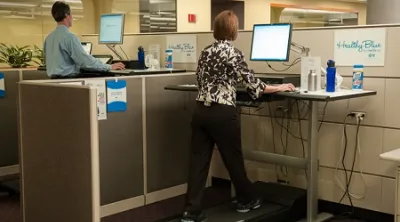Now more than ever, employers are embracing worksite wellness programs to improve the health of their employees, reduce absenteeism, recruit and retain the best and brightest, and produce medical cost savings in the long-run. In fact, 50 percent of small businesses and 80 percent of large employers throughout the United States offer some form of wellness program.
You’d be hard pressed to find a company that says that creating a culture of wellness at their workplace isn’t a priority. But how does a company truly go about doing this?
Blue Cross and Blue Shield of Massachusetts has partnered with employers to create worksite wellness programming for 25 years, and Blue Cross and Blue Shield of Massachusetts Wellness Consultants are assigned to approximately 300 employer accounts, ranging from small Massachusetts-based companies to municipalities, labor unions, and large national employers. We’ve found that each worksite is unique, but there are common components to success.
Make the healthy choice, the easy choice
Blue Cross and Blue Shield of Massachusetts encourages employers to think about what changes they can make in their work environment to make it easier for employees to make healthy decisions. Are there opportunities to offer standing desks or walking stations? How about ensuring there are safe and accessible areas for walking? Or how about providing a relaxation room or an onsite fitness center?
And don’t forget the cafeteria! Creating an affordable, healthy choice food policy that addresses cafeteria menu options (e.g., offering healthy foods at a discount), vending machines, and food selections for lunch meetings can go a long way to ensure that making the healthy choice is the easy choice.
Creating SMART goals for your wellness program
No different than any other business initiative, it is important to create objectives for your wellness programs which are:
- Specific
- Measurable
- Achievable
- Relevant
- Time-bound
These SMART goals can differ from employer to employer based on program priorities, but they are essential in ensuring everyone is on the same page when it comes to how success is judged.
Incentivize smartly
Incentivizing smartly doesn’t necessarily mean paying out the biggest bucks, but providing timely, relevant and meaningful rewards. While financial incentives can successfully motivate many of us to complete short-term activities and tasks, they have minimal effect and can even be counter-productive in driving long-lasting behavior change. The field of behavioral economics has shown that humans are often irrational in their decision-making – particularly when it comes to health. Accounting and designing for these common decision errors can drive better engagement and outcomes in wellness programs. For example, an immediate and visible reward – such as a gift card or other tangible reward—can have more impact than a premium reduction, which can be easily overlooked when distributed in small increments embedded in a bi-weekly paycheck.
An ongoing communications plan
One common thread throughout all successful wellness programs is strong, ongoing communications to employees. Because, if participants don’t understand how the program works, or when wellness events are being offered, no matter how great the wellness program is, it will fail. Employers are often great at communicating the launch of a new program or initiative, but often forget the critical step of creating an ongoing communications strategy.
Leadership must walk-the-walk, not just talk-the talk.
Leadership’s commitment to participating and promoting worksite wellness initiatives sends an important message to employees and is one of the key drivers of engagement. If possible, an employer should identify an in-house wellness leader and have a dedicated wellness program budget. We’ve also seen employers incorporate wellness program objectives into management training and performance goals of key leadership personnel.
A great wellness program isn’t created overnight
A great wellness program takes time and patience. One thing to watch out for is introducing too much, too soon, as this may lead to frustration if employees don’t jump on board right away. Getting worksite wellness right is a lot of work, but the payoff – happier and healthier employees – is absolutely worth it.

